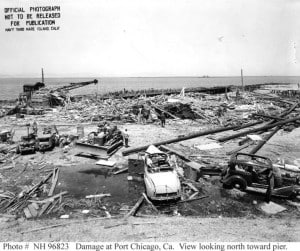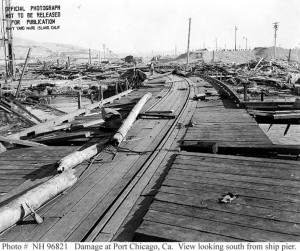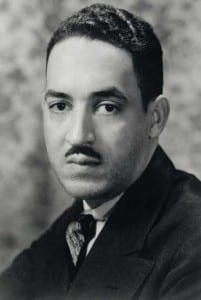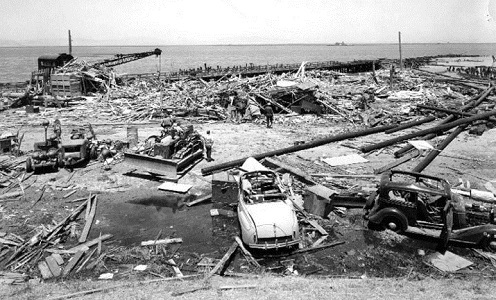African American History, California History, Napa
Port Chicago Mutiny
 The Port Chicago explosion on July 17, 1944, was the tragic result of ordering undertrained men into “manifestly unsafe working conditions at the base where only blacks were assigned the dangerous duty of loading ammunition.”[1] The Napa Daily Journal described the explosion in sensational detail a few days later, although it also curiously never mentions African Americans at all:
The Port Chicago explosion on July 17, 1944, was the tragic result of ordering undertrained men into “manifestly unsafe working conditions at the base where only blacks were assigned the dangerous duty of loading ammunition.”[1] The Napa Daily Journal described the explosion in sensational detail a few days later, although it also curiously never mentions African Americans at all:
Only a moment before quiet and deadly in the holds of two ammunition ships at Port Chicago, tons and tons of TNT, destined to shatter the bodies of Japanese in the far reaches of the Pacific, turned its insensate fury on its handlers Monday night in one of the greatest catastrophes ever recorded in annals of the United States Navy…In Napa, rumor immediately placed the blast at Mare Island Navy Yard, and scores of frightened citizens thronged the street in front of the police station seeking official word and news of kin employed on the shipyard night shift…
Plainly visible here was the towering pillar of flame that flared into the southern sky. The hills of the Napa Valley were momentarily illuminated as by sunlight. Scores of persons, convinced that an earthquake was imminent, ran from their homes in their night clothes.
Damage here was slight, with only a few windows shattered…One man, a resident of the Atlas Peak district, was so certain that the Japs had come, that he telephoned Undersheriff John Claussen and breathlessly reported three ‘Jap’ planes had roared close overhead just a few minutes after the blast. How he could have identified the planes even if they were Jap was not made clear.[2]
 In total, 320 men were killed – 202 of them Black – and 390 people were injured by falling debris. People in Boulder City, Nevada, felt the shockwave from the blast, and even San Francisco suffered damage.
In total, 320 men were killed – 202 of them Black – and 390 people were injured by falling debris. People in Boulder City, Nevada, felt the shockwave from the blast, and even San Francisco suffered damage.
When the men were sent back to loading ammunition a few weeks later, 258 refused. Fifty were “single out, charged with mutiny, court-martialed, convicted, and handed sentences ranging from eight to fifteen years imprisonment.”[3] Before their court-martial, many of the Black seamen were transferred to barracks at Mare Island Naval Shipyard. What Napa’s Black residents – especially those working at Mare Island – thought of the mutiny has not been discovered, but they must have had some interesting conversations. No local newspapers appear to have covered the trial results, either.
 Thurgood Marshall, working with the NAACP Legal Defense Fund, developed the appeal by launching a publicity campaign. The case against the Port Chicago 50 was reopened in 1945, and their sentences were soon reduced. On January 6, 1946, the Navy released 47 men, sent them to the Pacific Theater, and paroled them to menial labor. Two more were released later after recovering from injuries, and the final man was held for a history of bad conduct. All were later honorably discharged.
Thurgood Marshall, working with the NAACP Legal Defense Fund, developed the appeal by launching a publicity campaign. The case against the Port Chicago 50 was reopened in 1945, and their sentences were soon reduced. On January 6, 1946, the Navy released 47 men, sent them to the Pacific Theater, and paroled them to menial labor. Two more were released later after recovering from injuries, and the final man was held for a history of bad conduct. All were later honorably discharged.
[Ed. note: this article is excerpted in part from the master’s thesis “There Are No Black People in Napa”: A History of African Americans in Napa County by Alexandria Brown.]
[1] Eva Paterson, “Publisher’s Preface,” The Port Chicago Mutiny: The Story of the Largest Mass Mutiny Trial in U.S. Naval History (Berkeley, CA: Heyday Books, 2006): xi.
[2] Napa Daily Journal 7/21/1944
[3] Robert Allen, The Port Chicago Mutiny (Berkeley, CA: Heyday Books, 2006): xiii-xiv.


